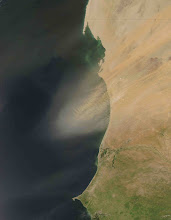
Photo of DA's recently flooded soccer field (at least
it has grass!) by my colleague, DA math teacher Lois Clark.
A few days ago, I learned that Senegal recently began managing a cooperative project with other West African nations to “seed” clouds in an attempt to increase rainfall in this seriously under-watered portion of the continent. Over here, the sky isn’t falling, and that’s a problem for subsistence farmers! Or it was. The cloud seeding project appears to be working.
Can you guess when the project started. (Hint: think “Katrina.”) That’s right! In 2005, when Dakar saw the most rain it’s seen in 30 years. And when numerous storms from Senegal and surrounding countries crossed the Atlantic, becoming hurricanes on the way.
For the following two years, apparently, no seeding was done, and rainfall dropped precipitously*. But this year, the project is apparently back in action, and we’re getting solid rains almost every night. And the Caribbean and North America are getting big hurricanes again!
The friend who first told me about the Senegalese use of cloud seeding was amused because this news pretty well puts the kabosh on theories that global warming is simultaneously causing the drought in West Africa and causing the increased rain storms in West Africa that lead to hurricanes.
Apparently, however, it is fairly well established that certain kinds of storm conditions here in West Africa do lead to the formation of hurricanes as they head west across the Atlantic Ocean.
If true that the seeding is working, and true that some of the storms turn into hurricanes, then human intervention in the weather to help starving people on one continent is leading to loss of life and massive destruction in North America.
* For those of you who don’t remember your high school Earth Science class, or who took something silly like Physics or Chemistry instead, “seeding” a cloud is a process in which some substance is injected into “pregnant” clouds—ones containing lots of tiny water droplets that are too light to fall as rain. The injected substances range from sodium iodide to dry ice. (I’ve heard that even cement powder has been tested). The effect is that the water droplets either freeze or combine to be heavy enough to fall as rain (or concrete, as the case may be).
** Wow! Did you catch that double pun? I’m impressed with myself!





